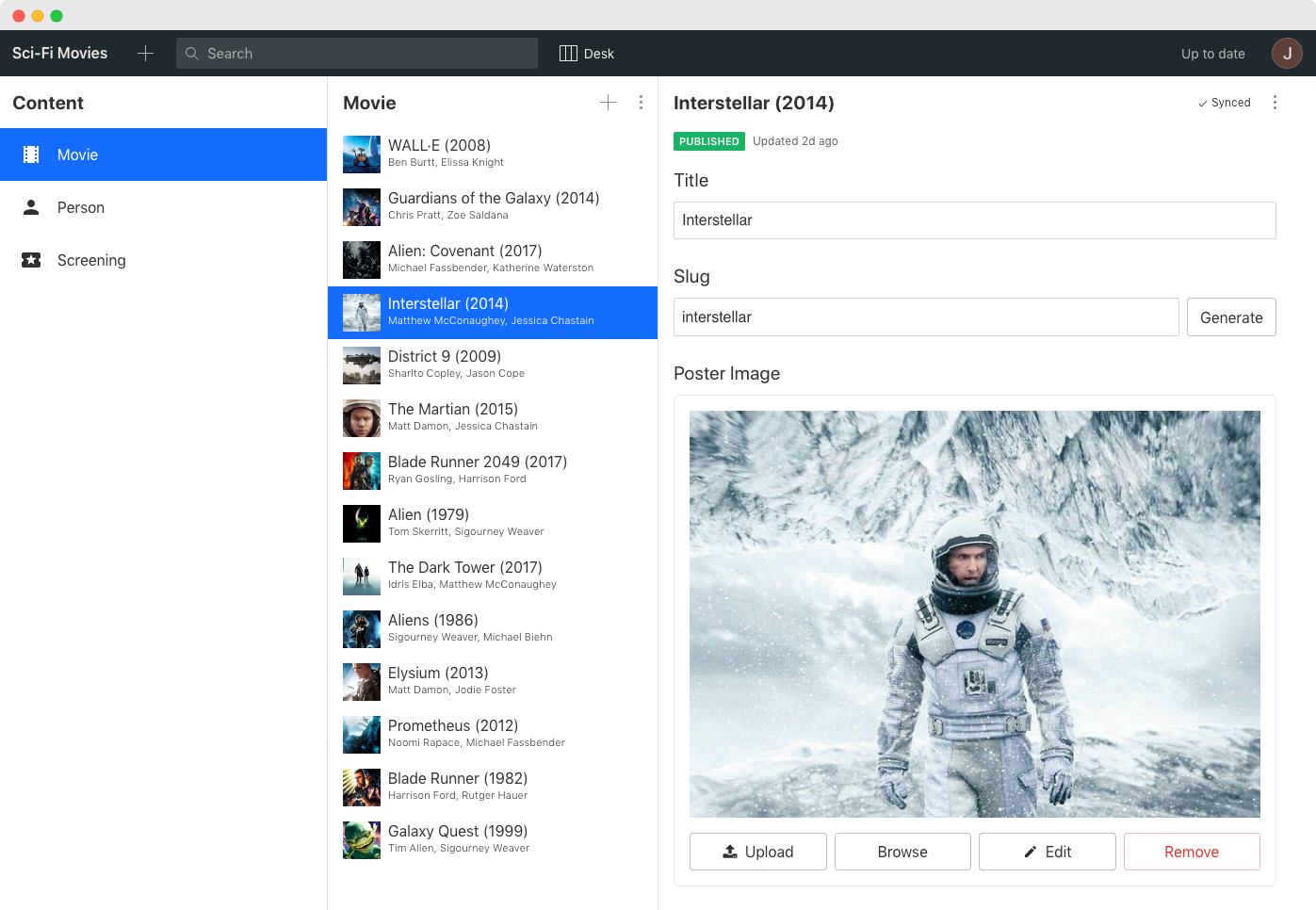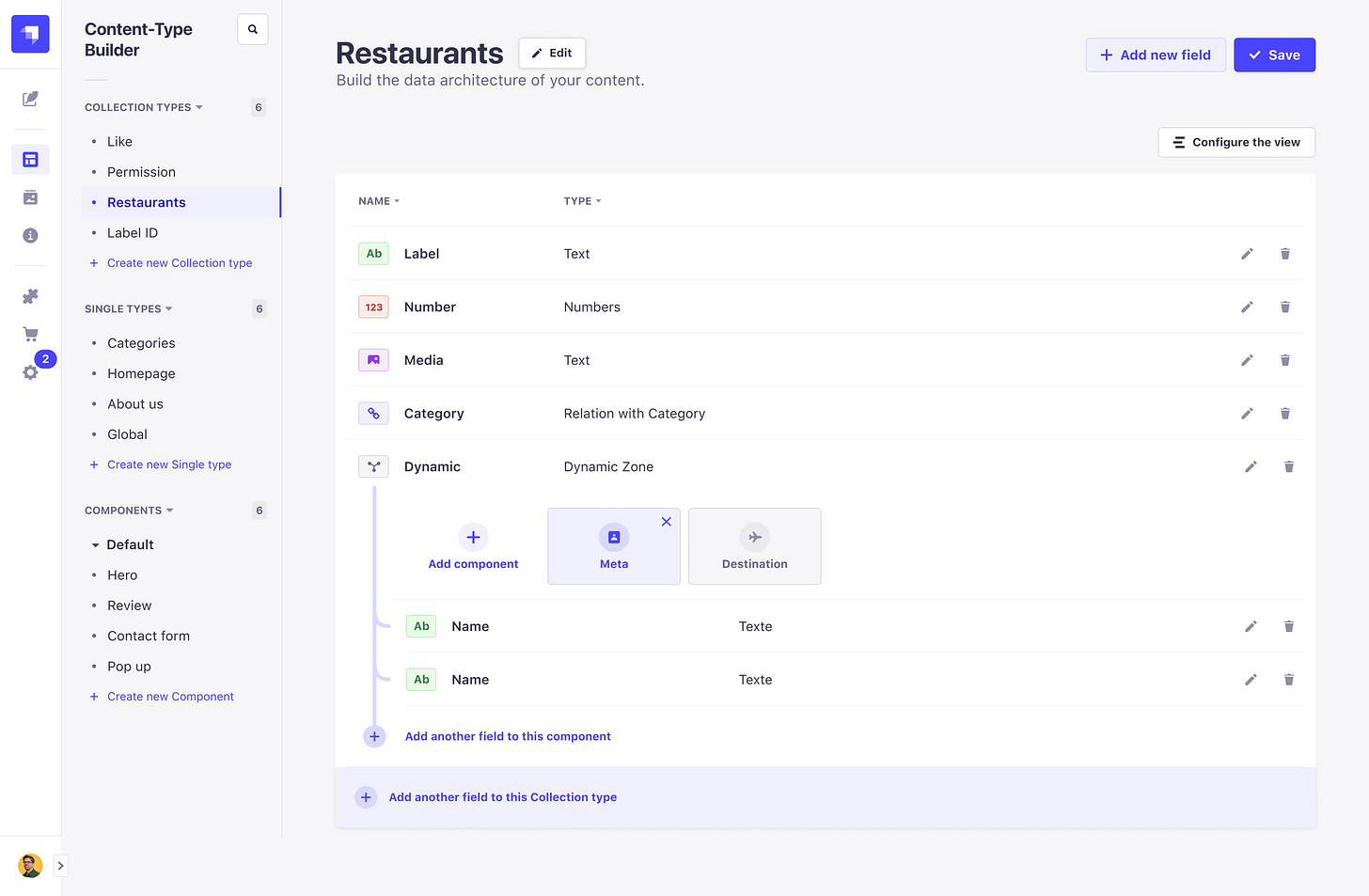Composable Content in 2023, a brief introduction.
New year, new cycle, new marketing promises. Composable content is likely here to stay, but is 2023 the year to make big moves?
Composable architecture was one of those big tech phrases of 2022, an expression that'll continue to be hyped up in 2023 — so you can expect composable everything with the marketing you’ll see. And this is why I’m writing to you today, about one of the derivatives or spin-offs emerging, called composable content.
Don’t get too excited, this still fits squarely in the “yet another CMS” territory (for now at least). For reasons I’ll explain, I think the concept and philosophies behind them hold promise and will likely become the future direction of content in large organisations.

What makes for (good) Composable Content?
What even is composable content? Well, they’re evolving towards becoming API-first organisation-wide content management solutions. The secret recipe that was handed down to me says 70% CMS, 10% APIs, 20% DAM, all glazed in bulletproof open-source licenses — but who am I to say. At its core it feels like we’re continuing to separate content management and content presentation, that’s the crux of the matter. The quote by previous CEO of Netscape, Jim Barksdale, comes to mind:
“There are only two ways to make money in business: One is to bundle; the other is unbundle."
This is definitely about the unbundling of the CMS as we know it — with the slick ultra-fast JavaScript frontends on one side (Next, React, Vue, etc.), and then you guessed it, composable content on the other. We can’t use the term headless CMS anymore, because that’s so last cycle (and the first rule of 2022 — is you don’t speak about 2022). Jokes aside, there is validity in the ambitions to go beyond structuring content as headless or decoupled — to the point that I feel like this is the type of shift that will make its way across a majority of large businesses within this decade.
Getting stuck into the actual concept, these are the principles I’m thinking about and looking for in a hypothetical Composable Content Platform. I’ll mention vendors further down, but let’s start with the ideal outcomes (which don’t exist as a single solution in the wild yet)…
A single source of truth for your content. We didn't need this 10 years ago, because your digital content was basically your 1 marketing website (if it still is, no comment 🙈). Today, the breadth of digital content spans your entire organisation and is exponentially larger. This source of truth can exist as a single solution/architecture or alternatively, as the ability to aggregate multiple sources seamlessly. A single solution will have many limitations, whilst the opposite, aggregating multiple sources will create some level of friction. I’ll get into some of this further below and subsequent posts.
As a company, you own your data. Any vendor (and really, all do) can make this claim in their marketing collateral, but I think it comes down to two things; 1) The content model and structured data is in such a format that is easily portable to different solutions, and 2) You are able to host the data on your own infrastructure/cloud account. If one of these two conditions isn't met, do you really own your data?
The core platform you use is open-source. Whilst I'm a big believer in open-source, I’m not a hardliner. I think a lot of exciting innovation and emerging tech is proprietary, and these toys are exciting to play with at the fringes of your MarTech stack. But your organisation's digital content is foundational, it will outlive your tenure. I think leaders have a responsibility to safeguard this IP for the long-term success and evolution of the business. I also say core platform, because there can be a rich ecosystem around this platform that isn’t always open-source (i.e. an open-source composable content platform connecting to closed-source content enrichment SaaS tools, that’s a sweet setup).
And lastly, you're able to layer on the best of content creation tools; no-code, collaborative, content manipulation, workflows, AI-augmentation, wide integrative landscapes — in other words, all of these rich and powerful tools marketers have gotten used to. I think this is arguably the largest dilemma between going with an API-first solution (headless-heritage) and a creator-first solution (CMS-heritage). For example, WordPress and Drupal have large ecosystems giving them an almost infinite source of no-code plugins to create, manipulate and augment content with. Trying to replicate that in newer headless solutions will take an insane amount of effort.
💡 Sidenote: Parallels between Customer and Content Data
Interestingly enough, all the principles I mentioned above have been part of the Customer Data Platform (CDP) battle the last few years. In that category, you essentially saw three options emerge:
Going with a pricey all-in-one CDP solution (Segment, mParticle, etc.)
Creating your own CDP using a data warehouse and various r-ETL solutions (Snowplow, Hightouch, Census, etc.)
Falling back on your existing platform suite’s bolt-on CDP (Adobe, Sitecore, etc.)
The four thematic principles I mention for composable content, all played and continue to play a role for how organisations choose their CDP setup (and thus maintain their customer data centrally). There are many learnings from the centralisation of customer data, that can be applied to this emerging centralisation of content data.
So which vendors are in play?
In no particular order, and disclaimer, my company works extensively with WordPress, no affiliation to any of the other vendors.
📦 Sanity
They’re really going for it when it comes to this composable content language. They’re almost completely open-source, have that developers by developers vibe and having watched a bunch of their YouTube content, feel very accessible and authentic as humans. They just released Sanity Studio v3, and some of the workflows and collaboration options are quite impressive. The only challenge I see for now is that they haven’t released a DIY connector for self-hosting your content lake (their term for data lake), you still have to subscribe to their SaaS offering. My assumption is that as they become more popular, AWS/GCP extensions to host on your own accounts will emerge quite quickly.
Sanity.io | Sanity Studio | Recent YouTube videos
📦 Strapi
Strapi is an alternative to Sanity, you can view a head to head comparison here. Their language is still firmly in the “headless CMS” territory, but maybe it’s just a matter of catching up as they seem quite similar. They’re not as popular as Sanity today, but also not far behind. A notable difference however, is that all the code to self-host your content lake is open-source. As such, in terms of my 4 principles, they might be the closest? Whilst I have installed and played with Sanity, I have yet to try Strapi, it’s on my list.
Strapi.io | Community Edition | Recent YouTube videos
📦 GraphQL Vendors

GraphQL is an evolution of the REST API and is quite amazing for querying content (don’t know GraphQL? 100 second intro to GraphQL). Within this space, two products are emerging with a solution-approach I spoke to earlier, aggregating multiple content sources seamlessly. They achieve this by essentially providing you with a graph of graphs, a single graph to rule them all. This means, you can pipe all your existing CMS, ecommerce, bespoke content, to then all be expressed through a single graph.
I really like this approach as it’s a very pragmatic and speedy way of bringing together multiple existing data sources. Whilst both companies are built on strong open-source foundations, these content hub solutions are paid SaaS products. I have no idea about pricing, but I assume them to be in the regular open-source & enterprise plan realm. One of them will probably end up open-sourcing the solution imho, or alternatively a Player 3 joins the arena and eats it all. Check them out here…
→ GraphOS (by Apollo)
Apollo | GraphOS / Launched Oct-22 | Recent YouTube videos
→ Valhalla (by Gatsby)
Gatsby | Valhalla Content Hub / Launched Nov-22 | Recent YouTube videos
📦 WordPress & Drupal
Whilst the developer experience of the API-first solutions above is well thought out, they lack those very rich, diverse and extensible content creation tools marketers have gotten used to. This is where some of our trusted “legacy” solutions still win over. WordPress is turning 20 soon (Drupal, 23) — and I know these aren’t the names you’re thinking of when you think of composable content, but that’s likely the result of under-marketing by the open-source CMS’s (and dare I say, over-marketing by the headless CMS’s).
Take WordPress as example. On top of its existing user-friendly block editor, there’s tens of thousands of plugins and integrations, many of which also connect directly into the templating engine (so creation + presentation in one). These end-to-end no-code solutions, result in a very powerful solution that’s hard to displace by any new entrant (and no funding can outpace the contributions made to successful open-source projects). WordPress, Drupal, etc. are still the superior solution for publishing rich content imho (especially for article-heavy sites, newsrooms, marketers needing to organise front-end presentation, no-code teams, etc.).
📦 Losers of 2023?
Whilst I think the solutions mentioned above will enjoy growth, some others will face tough times, and we should talk about that. Closed-source or proprietary solutions that took the headless route in recent years, will see their hype fade the most imho. The space is already maturing and becoming increasingly commoditised through strong open-source foundations. This begs the question, why would organisations choose closed-source and costly vendors at such a time? Few examples of vendors I think will see decline this year:
Contentful (”… composable content platform”)
Optimizely (“… world’s leading and fully-composable Digital Experience Platform”)
Sitecore (“… one home for all your digital assets, content operations, and distribution”)
An organisation’s foundational digital content belongs further upstream, leveraging open-source to make anything available anywhere across a multitude of teams and silos. The open-source players are amassing developer support, from which the upsell into cloud hosting/enterprise support is a no-brainer. Open-source solutions with traction will be infinitely more sticky for the years to come (just look at Sanity’s organic growth).
So now that we’ve sipped some of that composable Kool-Aid, what’s next?
What action to take in 2023?
With tighter budgets persisting and composable content still finding its feet, I don’t think there’s any immediate action to take. It’s a cool phrase, ambitious concept but there’s no urgency. I have a tendency to get ahead of myself, but at the same time I know this is a great year for change and keeping an open-mind.
It’s always good to be playful, or rather, it’s necessary to be playful and experiment. Industry analysts will all tell you that turbulence and chaos are the new normal, so we might as well all have some fun. If I was looking for ways to play here though, I would try and create new value in small doses, instead of going through any all-in migrations (that’s at least what I’m recommending to our clients).
A progressive and pragmatic recipe for 2023 could look like this:
Use Sanity or Strapi for new/smaller projects with bespoke or non-traditional content models. I’d argue these solutions are at the point where they improve on a CMS’s approach to create custom content types (in other words, keep your CMS for crafting pages and explore API-first content solutions for managing bespoke content models).
Then, experiment with Valhalla or GraphOS to bring together your new and existing content sources together (Sanity, WordPress, Shopify, etc.). As this is an abstraction, there’s no impact on your current front-end/digital experiences, they’ll still function as they did yesterday.
From there, build GraphQL queries and React components (or “molecules”, using the Atomic Design concept), which you can re-use across multiple channels, and potentially use to even start replacing parts of older channels (only where it brings value obviously, as CxO’s will be breathing down your throats for ROI after all). Hybrid headless setups are much easier to ease into than full-blown re-platforming projects.
The above setup introduces you to the concept of creating a content-component once, and distributing it everywhere.
I’m keen to understand how some of you are approaching this move to composable content — if you’re going through anything like this (or thinking about it), I’d love to chat about it (hello at noeltock dotcom).
Final thoughts
Stepping back, if the holy grail of personalisation is marketing to an audience of one, then the holy grail of composable content is still a few light years away. The vendor landscape simply hasn’t evolved into a complete picture yet. What I mean by that is that it’s still anybodies game. Hear me out…
With the continued atomisation of content within CMS’s, you may well see some of these “legacy” CMS’s take the leap into becoming content repositories with a broader mandate themselves (playing the Uno reverse card, and essentially unbundling themselves). Where I think solutions with an API-first or headless-heritage take a bottoms-up approach to tackling this problem space (build your own content model from scratch, small ecosystems, lots of bespoke code), solutions with a CMS-heritage can take a top-down approach, working backwards from the atomic unit of a page to that of a content fragment, all whilst leveraging its years of UX experience and vast ecosystem to support them. The theory is great, but we need to see this convergence towards a best of both worlds setup play out.
The only constant for now is the continued open-source commoditisation of this problem-space, and anyone claiming otherwise is trying to claim their spot on the map prematurely. I will continue to write on this topic as the space evolves.
I welcome all thoughts, comments, experiences, calling out factual errors below, thank you 🎉
About DXP.WTF is an independent newsletter written by Noel Tock. It focuses on the future of enterprise software, martech stacks and beyond. As the name (not so subtly) hints at, Noel’s aim is to cut through the mountains of vendor marketing and hype, to explain things as they are from his perspective — to ultimately help decision-makers navigate the future and make better decisions.
About the Author - Noel has been building online things since 1995. From founding an award-winning FPS game, to building large online communities, all the way to product design and developing SaaS/web applications — he’s focused the last decade on bringing open-source to enterprise/big media. He’s a co-founder of Human Made, one of the agencies behind big WordPress sites. You can find him here LinkedIn | Twitter / noeltock.com




Noel - great article. I'm really with you about the whole Composable Content approach.
And I really can't image having a CMS in 2023 that doesn't have an API. Monoliths still have a lot of sense in many cases, but because of the single source of truth approach regarding our content, we have to always be prepared for using our monolith CMS also a a source of content for an mobile app or some additional pages.
With the above in mind - CraftCMS and Statamic are also doing a great job.